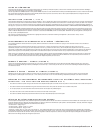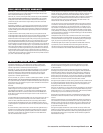
Contact Polk Audio Customer Service 1-800-377-7655, polkcs@polkaudio.com
HOOK-UP METHOD #3 (FIGURE 9)
This method is for use with electr
onics featuring “PRE OUT” jacks—and may be used as a secondary hook up method for use with compact satellite speakers such as Polk RM
Series. Connect the left and right pr
eamp output from your electronics to the left and right LINE LEVEL input of the subwoofer. This may require use of RCA “Y” cables (not supplied)
to hookup both the subwoofer and your power amplifier. When using method #3, it is necessary to adjust the settings on your preamp/processor as follows: Front speakers = LARGE;
Subwoofer = “OFF” or “NO.”
AC POWER CONNECTION AND AUTO ON/OFF (FIGURES 10, 11 & 12)
These PSW series subwoofers featur
e auto on/off circuitry, marked “auto” on the power switch, that automatically turns your subwoofer on when it senses a program signal. When
no signal is present, the circuit turns the subwoofer off after a few minutes. If you are concerned about the brief delay between when the music starts and when the subwoofer
turns on, simply leave your subwoofer in the “on” position. When the power switch is set to “OFF” (PSW303 or PSW404) or “STANDBY” (PSW505) it consumes a low amount of
power
. If this is a concern, you may want to leave your PSW system unplugged during extended periods of non use, such as during a vacation.
Note (PSW505 owners only): Your PSW505 has a detachable power cord.
SUBWOOFER ADJUSTMENTS (FIGURES 10, 11 & 12)
Your Powered Subwoofer offers a range of setting options. We recommend the following settings as starting points, but the settings that are best for you depend upon your speaker
placement, electr
onics and personal taste. After you’ve become familiar with what the settings do, experiment with alternate options to find the method that works best for your sys-
tem setup. Y
ou’ll find an informative article on “Subwoofer Positioning and Adjustment” in the set up section at: http://www.polkaudio.com/home/faqad/.
“MAKING ADJUSTMENTS” OR “FINE TUNING” (FIGURES 10, 11 & 12)
• For RM System adjustments please r
efer to their owners manuals.
• V
olume—Adjust by ear using a wide variety of CDs and video sources. Adjust for deep, powerful bass without “boominess.”
• Low Pass—This contr
ol adjusts the frequency range over which the subwoofer operates. When using smaller main speakers, the upper range of the control will probably yield
the best results. With larger speakers, the lower end of the control range will probably sound best, but always let your ear be the final judge. If male vocals sound “thin,” turn
this control up until the voice sounds rich but not boomy. If male vocals sound too “thick” or “chesty,” turn this control down until the voice sounds natural. NOTE: This control
does not operate when the subwoofer is connected with Method #2 (LFE Input).
• Phase Switch—Have someone switch between the two settings while you sit in your favorite listening position. Use music with good bass and a deep male vocal. When you
hear the best balance of deep bass and natural lower octaves of the male voice, you have achieved optimum phase tuning.
Q: “
Why does my system hum?”
A: “Because it doesn’t know the words.”
This is what passes for humor in the audio business. Here’s the real answer: If you have any electrical (50/60Hz) hum in your system you’re going to hear it clearly as soon as you
hook up your subwoofer. Most hum problems are caused by “ground loops.” That is, the electrical grounds of the components in your system are not at the same electrical poten-
tial. A very common ground loop source is cable TV. Disconnect the coaxial cable from your TV and/or VCR. If the hum goes away, the cable is the ground loop villain. In that case
you need a 75 ohm ground loop isolator. This device attaches to your coaxial cable where it plugs into your VCR (or television). They’re simple to install and usually solve the hum
problem. Find 75 ohm ground loop isolators at your audio dealer, Radio Shack stores, or online at http://shop.polkaudio.com.
Ground loops and hum can also be the result of faulty electrical wiring in your home. Consult a licensed electrician to evaluate and, if necessary, repair the AC wiring in your home.
Light dimmers also tend to introduce noise into audio systems. Remove them.
If none of our suggestions work for you, contact Polk Audio Customer Service 800-377-7655 (US & Canada), 410-358-3600, 9am-6pm EST, Monday through Friday, or email:
polkcs@polkaudio.com.
TECHNICAL ASSISTANCE OR SERVICE
If, after following these hook up directions, you experience difficulty, please double-check all wire connections. Should you isolate the problem to the speaker, contact the autho-
rized Polk Audio dealer where you made your purchase, or call Polk Audio’s friendly Customer Service Department at 1-800-377-7655 (calls from US or CAN only), 410-358-3600 9am
to 6pm EST
, Monday thr
ough Friday
. Y
ou may also contact us via email: polkcs@polkaudio.com.
For more detailed hook up information and manual updates, visit:
http://www.polkaudio.com/home/products/subwoofers/psw303
or
http://www
.polkaudio.com/home/faqad/
For recommended accessories (including speaker stands, brackets, accessories and exclusive Polk Audio logowear), visit our Webstore: http://shop.polkaudio.com.














